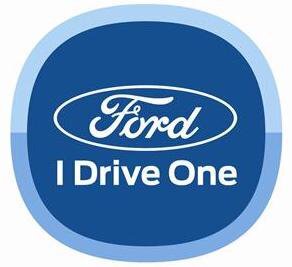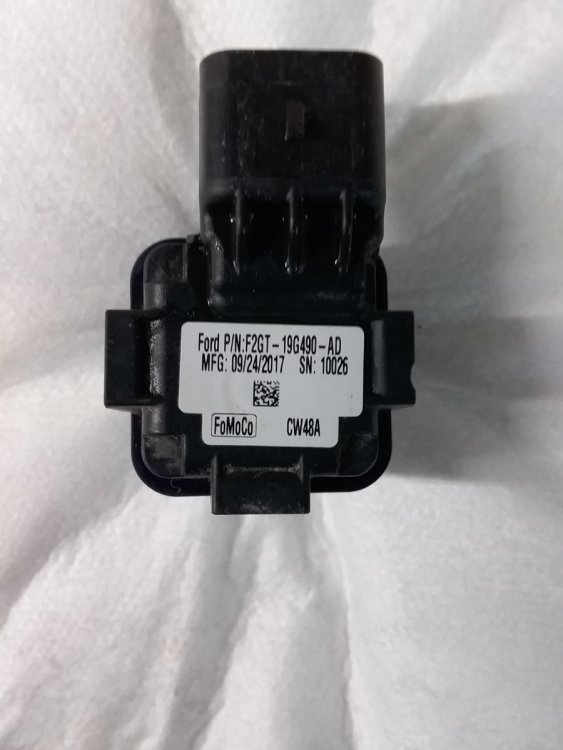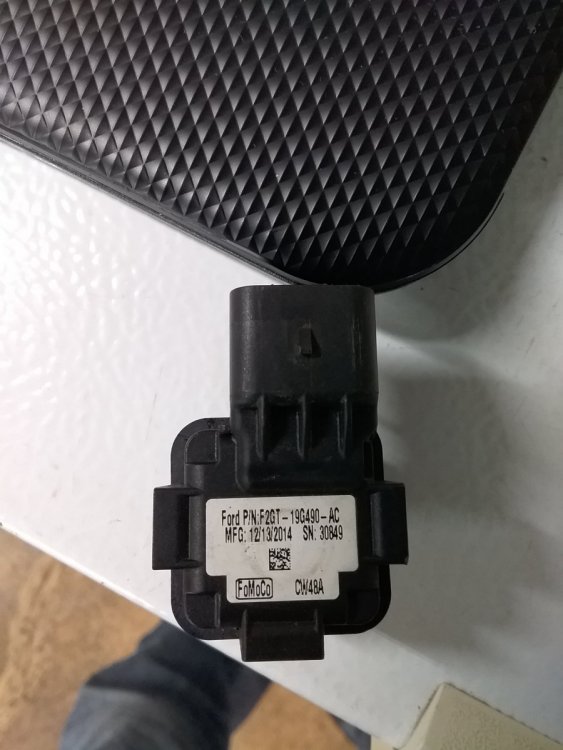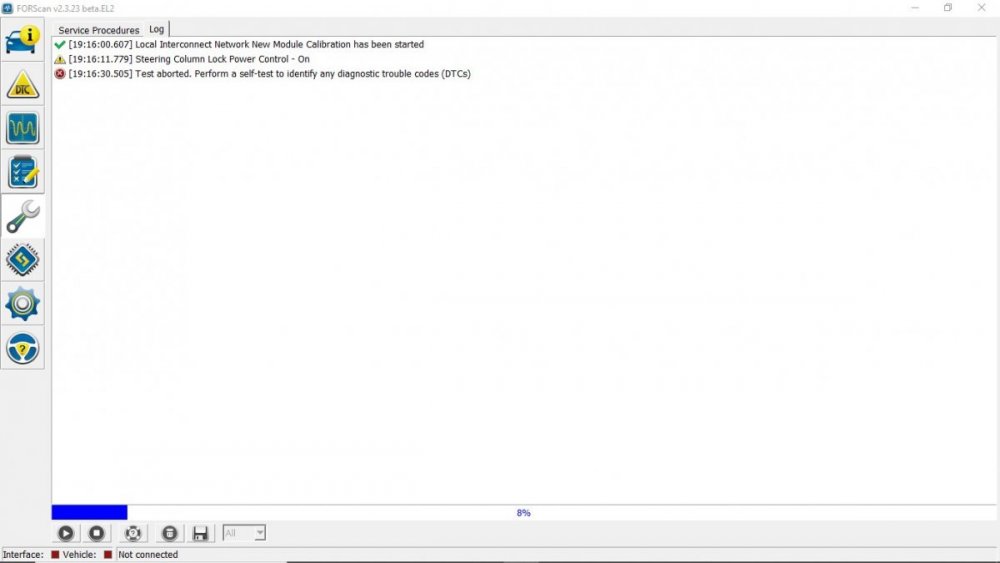

Dmtaurus
Edge Member-
Posts
36 -
Joined
-
Last visited
Content Type
Profiles
Forums
Gallery
Everything posted by Dmtaurus
-

AM Band on Radio Has Ticking Sound
Dmtaurus replied to Dmtaurus's topic in Audio, Backup, Navigation & SYNC
Another couple of things I like about the Denso part is the box says they are made in the U.S.A.; I applaud that! The second thing is the engine acceleration is so much smoother than when the Motorcraft units were in place. Now maybe the Motorcraft units were starting to wear out; maybe coils weaken over time rather than just quit; I never got a check engine with them. Nevertheless, so far I am happy with the Denso performance. -

AM Band on Radio Has Ticking Sound
Dmtaurus replied to Dmtaurus's topic in Audio, Backup, Navigation & SYNC
Well, I finally got around to performing further testing of the ignition coils. I reviewed everything that I could visibly see and also by using a DVOM to check across the plug terminals for any resistance differences. The meter showed meniscal differences in resistance readings. So, I decided to buy new coils and replace the originals from RockAuto after reviewing the offerings and the prices The spark ticking is now gone. The new coils are Denso brand and the housings are almost a carbon copy of the Motorcraft coils; even the mold numbers are the same except for 2 blanked number sets. Maybe Denso makes the Motorcraft units. Thanks for everyone's help. -

AM Band on Radio Has Ticking Sound
Dmtaurus replied to Dmtaurus's topic in Audio, Backup, Navigation & SYNC
No, I did not. That would be the next step, or, to buy a known good coil as a substitute test unit. One curious thing I noticed is that when the engine was cold, when I was doing the removing and re-installing of the coils, and next started the engine, that the ticking was gone and that it didn't come back until a later engine start up. The breakdown of the coil must be taking place when the coil gets warmed up. What I did find when looking into how the three-prong coils work is that a transistor is built into the coil that receives a signal from the PCM through one of the prongs to switch the 12 volts coming to a second prong, that is going to the wraps to build voltage to fire the plug. The third prong is a ground, my guess for the transistor to function. So what you said earlier makes more sense in that the breakdown isn't something you can see on the outside of the housing but instead takes place on the inside, where it is hidden under the encapsulant, and under a condition where the coil is somewhat warm. -

AM Band on Radio Has Ticking Sound
Dmtaurus replied to Dmtaurus's topic in Audio, Backup, Navigation & SYNC
Well, I removed each coil and used a 4X eye loupe to look for carbon tracks over the entire housing and in the receptacle entrance. I found no tracks or cracks. Each electrical plug at the harness appears to be in good condition. What I wonder is why there are three male prongs in the coil. There must be a dielectric test that is performed on the production line to screen for voltage breakdown, to make sure those coils are rejected before shipment. My guess is that one of the prongs is a ground; I don't know which one it might be. -

AM Band on Radio Has Ticking Sound
Dmtaurus replied to Dmtaurus's topic in Audio, Backup, Navigation & SYNC
My guess is that I should see carbon tracking around coil housing if the leakage is there. -

AM Band on Radio Has Ticking Sound
Dmtaurus replied to Dmtaurus's topic in Audio, Backup, Navigation & SYNC
Excellent hints. I will check the G110 ground too. I am curious about the capacitor; what does it look like? And I wonder if the 2015's had the same RNR capacitor. -

AM Band on Radio Has Ticking Sound
Dmtaurus replied to Dmtaurus's topic in Audio, Backup, Navigation & SYNC
All great answers; thanks. If I remember correctly the radio noise problem from my after-market radio days some 40 years ago, there were 2 major divisions between noise interference. First, whining signified that it was noise generated by the alternator and this would change to a higher pitch with increasing engine rpm. The second noise was a noise generated by leaking ignition wires or non-resistive spark plugs and the noise would change as engine rpms changed but it would not vary much in pitch. Mine is the second. I'll try to pull off the cover over the engine top and turn out the lights to see if any stray sparking around the ignition coils is taking place. I am stumped, though, how a bad alternator can cause poor reception. I have a 2013 Taurus and AM works great and pulls in the distant stations with ease. But the Edge has always been somewhat lousy on AM. And e2, you are right; it doesn't make noise on the satellite or the FM band. Their signals are clean. -
Have a 2015 Edge SEL with the touch-screen, radio and HVAC controls. When listening to AM radio with the engine running, I hear a ticking sound from the speakers that varies with the engine speed. It is not a whine, like the noise that is generated by the alternator, but rather a ticking noise like the noise generated by a bad spark plug wire. Since it is a 2.0 with coil on plug, I am stumped as to what is causing it. I was trying to find grounds and I found one under the hood, on the driver's side towards the strut tower. I cleaned it's ring terminal and applied Never-Sieze, but that didn't help. I'm not sure where to look. Any ideas or TSB's out on this? It has the antenna for satellite radio, but an antenna for AM might be between the roof and headliner.
-
Have a 2015 Edge SEL, 2.0 Ecoboost, FWD, 86K miles, with what sounds like a bearing groan. I replaced both front wheel bearings with SKF units 1500 miles ago, so I don't think the groan is from them, and I don't detect any noise from the rear bearings. I have BF Goodrich tires on it and they are like new even though they are 2 years old. It drives straight as an arrow and tire wear is excellent. I was thinking bad front CV joints on the axles but they don't click or skip at all. Turning left or right makes no difference in the sound, like when the wheel bearings get loaded in a turn. Driving on asphalt or concrete doesn't change the tone or loudness. Then this thought occurred; the support bearing on the front passenger axle that is saddled to the engine block. 1, Do these go bad and groan when the miles accumulate? The groan seems to be coming from all directions, so it is hard to pinpoint the direction. 2. I see on RockAuto that the listings for this model make a point to say that the front axles are an updated design. What does that mean?
-

2015 Edge Wheel Bearing, Front, 2WD, 83k Miles
Dmtaurus replied to Dmtaurus's topic in 2015 Edge & MKX
Thanks for the replies. While waiting for replies to my question, I took a close look at the Motorcraft photos on Rockauto and see that they are FAG bearings, and they are made in Slovakia. So, I took a chance and ordered the SKF bearings and when they arrived, they too said FAG on the hub. I can only deduce that FAG makes them for other bearing companies, depending if it makes sense from a business standpoint for both parties. I also wrote direct to SKF and was told that this model number is made in Slovakia, like the FAG unit. SKF also attached their warranty for this bearing, which appears to be 3 years or 45,000 miles, if installed correctly. I uploaded the document. I tend to think that they are a quality bearing because SKF is a renowned bearing maker for all types of applications. I have used them in past material handling projects and they performed well. Timken makes quality parts, but I was surprised they don't provide a replacement unit. Warranty.pdf -
I believe I have a groaning left front wheel bearing on my Edge with 83,000 miles. I was looking at RockAuto and the only makers that seem to be the best are Motorcraft (I think FAG makes theirs from the photos) and SKF. Does anyone have experience between the 2 makers for providing a quality, long-lasting unit? The price difference is 50 bucks more for the Motorcraft unit versus the SKF unit.
-

Update Your Gen2 Edge To The Latest Sync Version
Dmtaurus replied to Gadgetjq's topic in Audio, Backup, Navigation & SYNC
So, will this update work on my 2015 Edge SEL? It does not have the navigation icon but rather the information icon at the top right corner.- 43 replies
-
- sync update
- sync 3.4
-
(and 1 more)
Tagged with:
-

Rear Camera White Steering Lines
Dmtaurus replied to Dmtaurus's topic in Audio, Backup, Navigation & SYNC
Well, after installing the Dorman camera about 2 years ago I finally got the fix. I tried on at least 4 occasions to work with Dorman on a fix as to why their camera does not display the white steering lines correctly. They suggested that I get a second replacement and the second camera did the same thing as the first. They asked for VIN; I gave them VIN. They said they turned it over to their test vehicle techs to get try to simulate the condition. I checked back at least twice over the course of time and it was, "We have it staged and will be working on it." After all this time I tired of their responses and excuses. Best price I could get from a Ford discount supplier was $270.00, and that is just too much money. So, I went on over to LQK and shopped for a used camera. I picked one from a 2018 Edge, since from what I found the 2015 through 2018 Edge rear cameras are the same. I installed it and the white steering lines are back and it functions as it should. I was able to calibrate it with Forscan and it achieved 100% calibration. The Dorman camera would stop at 8% calibration, and then Forscan would quit the calibration and give an error. I paid $79.00 total with s/h and that includes their optional their 2 year replacement warranty. I attached a photo of the old 2015 camera showing the Ford part and of the 2018 camera showing the Ford part number. I am pleased with how this turned out and I hope this story will help others.- 1 reply
-
- 3
-

-

-
Yeah, I saw the price and will order that. I can cut the line just before the sensor and after the last 180 degree bend, remove that end and release the other end at the charcoal cannister, and slip an emission-grade hose as a splice over the lines and use spring clamps over the ends. I can't see anything wrong with that as long as the hose is emission grade. NAPA sells that grade of hose. Ford did another mechanic blunder when they put a sensor in area where it cannot be easily replaced without major disassembly effort. I wish these engineers had to work on what they design; that might stop some of this stupidity.
-
Thanks for the door info. Thanks for the advice; don't necessarily agree with it; but thanks.
-
My 2015 Edge fwd has a dash lamp lit. I had it to the dealer and the dealer said that the plastic line with the vacuum sensor, that runs from the gas tank to the charcoal canister, needs replaced because the sensor in the line is bad, at a cost of about $375.00. The dealer said the gas tank has to be dropped to uncouple the line and remove it from the tank. Is that true? I was hoping to find a removable access panel under the rear seat to get to the coupling so it could be disconnected and the line fished out. Otherwise, I am thinking of buying a new plastic line assembly and splicing a section of the new line and sensor into the old line, and joining both with a piece of fuel line and clamps.
-
I use the OTC cannister unit and fuel injector cleaner, and induction system cleaner, on my naturally aspirated Taurus 3.5 and it works well. But with your answer on the induction part it sounds like a no-no and not the right solution. But now, I am curious about the need for, and the use of, OTC injector cleaner for using it on the direct injector set-up of this engine, if it should be done as routine maintenance.
-
Since the 2.0 is a GTDI engine, has Ford come out with an approved method for cleaning it? Motor magazine as of 2017 said that any cleaning using typical cleaners should not be used on turbo engines at all, and this includes CRC brand GTDI cleaner that is spray into the intake system.
-
Thanks, I'll check it out.
-
I have the bulging lug nut problem, like most Edge owners in salt-laden states. I have read the posts from others that had the same problem and they tended to use the McGard replacement bulging chrome lug nuts instead of the cheaply made Motorcraft OEM unit. Are those owners that used the McGard's still satisfied with them? Summit Racing has them for $17.99 for 4 and that is the best price I can find.
-
I have a 2015 Edge SE with the 2.0 automatic and front wheel drive set-up. It has 71,000 miles and there is no shifting or leaking problems with it. I drained the fluid 2 months ago for the first drain and fill fluid change. I then put about 500 miles on it and did a second change. I then just did a drain and refill again, about 500 miles since the second, and the fluid still looks extremely dark with just a hint of ruby red color. The total amount of fluid I have used so far is about 14 quarts. The fluid I used is Walmart Mercon 6 LV for Fords. I saw somewhere that these Edge transmissions turn the fluid dark, even after a short time period. I have also performed the same change process on my 2013 Taurus and it's fluid color still is ruby red after each change. Is this fluid color normal for these Edge transmissions? Should I go to the dealer and now have a complete internal chemical cleaning, and flush, and refill? At about $28.00 for each drain and refill it is becoming a little pricey.
-

Rear view camera guidelines are missing
Dmtaurus replied to ciggy's topic in Audio, Backup, Navigation & SYNC
From what I have read the wizards at Forscan have no desire to try and get aftermarket cameras to work with the factory rear-view set-up. Also, I installed a Dorman camera to replace the failed Ford camera and the white steering lines don't display correctly. I took the vehicle to the dealer for a recall and they updated Sync and they said they got the camera to work right for about 10 minutes and then it went back to the steering line error. I tried Forscan but the programming timed out after 8% completion. I wrote Dorman and got a reply that they would try their camera in a test mule Edge to verify the white line error if I sent them the last 5 or 6 digits of the VIN, which I did. That was last October. I just wrote them several weeks ago and they still haven't done the experiment. Given the state of the world I don't know if they will ever get to it. But the thing I do know is that after 2 separate tries with new Dorman cameras they are not a drop-in replacement and they don't work right. -

Adding Navigation - How Do I Do That?
Dmtaurus replied to Dmtaurus's topic in Audio, Backup, Navigation & SYNC
No, I set the navigation thing aside until I can get the rear camera active white steering lines to work properly when it is in reverse. I didn't want to install new software that might make the camera quit completely. What I have found out along the way over the last 6 months is that MFT and Sync are the lousiest software packages that Ford could have chosen, and this comes from Ford engineers. -
The factory, rear camera failed on my 2015 Edge SEL so I replaced it with a Dorman brand camera. My Edge was built after 01/15/2015 so fortunately it is the cheaper replacement model camera. The camera vision is restored but the moving white steering lines are weird. Here are the symptoms: Scenario 1 1. Shift to reverse and the colored lines are present and the white steering lines appear in response to the steering wheel angle. 2. Release the brake pedal and start moving backwards and the lines shift to the right in response to turning in the right direction. 3. When the reverse speed is increased then abruptly, the white steering lines shift to the extreme left and they stay locked there until the reverse movement is allowed to coast to a stop or when the brake is used to stop the reverse movement. The white steering lines then re-align themselves to the steering angle position that the steering wheel happens to stop at. Scenario 2 1. Shift to reverse and the colored lines are present and the white steering lines appear in response to the steering wheel angle. 2. Hold the brake on so there is no reverse movement and turn the steering wheel all the way to the right and then all the way to left. 3. The white steering lines follow the steering wheel perfectly. *Scenario 2 also behaves in the same way when the shifter is shifted from reverse to neutral. I chatted with Dorman and the Dorman tech thought that the camera could be defective and suggested that it be replaced under warranty. I contacted the vendor, gave him the information from the Dorman tech and an email contact address, and the vendor sent a new replacement camera. I installed the replacement camera and the exact same white steering line problem is still present. I then used Forscan to reset the Local Interconnect Network New Module Calibration under the service function icon (there is no camera reset option). The procedure started and what appeared at 8% completion was: (WARN) [19:18:32.882] Steering Column Lock Power Control - On (ERR) [19:19:01.359] Test aborted. Perform a self-test to identify any diagnostic trouble codes (DTCs) I checked for any DTC's and none were listed. I performed in Forscan the service procedure module resets of the APIM, FCIM, PSCM, and SCCM modules. It did not cure the problem. I took the Edge to the Ford dealer for the steering rack bolt recall and while there asked them to perform a diagnostic on the camera. They did a software update to Sync 2, and the white steering lines started working in a normal manner. They turned the engine off, waited 10 minutes, started it, the white lines still worked ok, and then turned it off. An hour later they started it and the white steering lines went back to the same mess. The service rep said the problem was probably a defect in the computer behind the 8" touch screen and that it might be a communication problem with the other modules. That doesn't make sense to me because when the vehicle is in reverse and stopped the white steering lines behave normally. I have read that people have changed the numbers in particular module code lines for the same camera white steering line problem in other Ford models, but I have not read anything that is specific for the 2015 Edge. Is there a cure for this problem?
-

Rear view camera guidelines are missing
Dmtaurus replied to ciggy's topic in Audio, Backup, Navigation & SYNC
I found 2 instances of this function; one under the BCM module and one under the Parking Aid module. I tried running the service function under each and both aborted at 8%. I did a screenshot from Forscan but I am not sure how to fix it. Any idea on what to do next?



